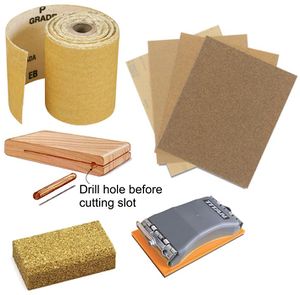Glasspaper: Difference between revisions
From DT Online
m (Improved presentation) |
(Added Template) |
||
| (4 intermediate revisions by the same user not shown) | |||
| Line 1: | Line 1: | ||
[[File:Glasspaper.jpg|300px|right]] | [[File:Glasspaper.jpg|300px|right]] | ||
__TOC__ | |||
=====Description===== | |||
[http://en.wikipedia.org/wiki/Sandpaper '''Sandpaper'''], [http://en.wikipedia.org/wiki/Sandpaper '''Glasspaper'''] and [http://en.wikipedia.org/wiki/Garnet#Industrial_uses '''Garnet papers'''] are commonly available in [http://en.wikipedia.org/wiki/Sandpaper#Grit_sizes '''grit sizes'''] ranging from 40 to 320 and used mainly for dry sanding of wood or paint removal. | [http://en.wikipedia.org/wiki/Sandpaper '''Sandpaper'''], [http://en.wikipedia.org/wiki/Sandpaper '''Glasspaper'''] and [http://en.wikipedia.org/wiki/Garnet#Industrial_uses '''Garnet papers'''] are commonly available in [http://en.wikipedia.org/wiki/Sandpaper#Grit_sizes '''grit sizes'''] ranging from 40 to 320 and used mainly for dry sanding of wood or paint removal. | ||
=====Features and Applications===== | |||
Grades 80, 120 and 240 would provide a useful range for general wood finishing. | Grades 80, 120 and 240 would provide a useful range for general wood finishing. | ||
Finer grits are also available, sometimes known as '''Flour Paper''', and used for cutting back raised grain between varnish coats for example. | Finer grits are also available, sometimes known as '''Flour Paper''', and used for cutting back raised grain between varnish coats for example. | ||
| Line 8: | Line 17: | ||
---- | ---- | ||
<span style="color: green">'''Note:''' | <span style="color: green">'''Note:''' | ||
Wrap around a cork sanding block when sanding surfaces or clip into a block made or sold for this purpose. Use dry and alter the direction as grades are worked through to remove scratches - but avoid sanding directly across the | Wrap around a cork sanding block when sanding surfaces or clip into a block made or sold for this purpose. Use dry and alter the direction as grades are worked through to remove scratches - but avoid sanding directly across the [https://en.wikipedia.org/wiki/Wood_grain '''Grain'''] and always finish with the grain. | ||
</span> | </span> | ||
---- | ---- | ||
Washable and reusable '''Sanding Sponges''' are also available and are useful for sanding curved and contoured surfaces. | Washable and reusable '''Sanding Sponges''' are also available and are useful for sanding curved and contoured surfaces. | ||
{{Abrasives Buyers Guide}} | |||
[[Category:Primary]] | |||
[[Category:Secondary]] | |||
[[Category:Shaping, Abrading and Finishing Tools]] | |||
Latest revision as of 08:37, 13 September 2016
Description
Sandpaper, Glasspaper and Garnet papers are commonly available in grit sizes ranging from 40 to 320 and used mainly for dry sanding of wood or paint removal.
Features and Applications
Grades 80, 120 and 240 would provide a useful range for general wood finishing.
Finer grits are also available, sometimes known as Flour Paper, and used for cutting back raised grain between varnish coats for example.
Note: Wrap around a cork sanding block when sanding surfaces or clip into a block made or sold for this purpose. Use dry and alter the direction as grades are worked through to remove scratches - but avoid sanding directly across the Grain and always finish with the grain.
Washable and reusable Sanding Sponges are also available and are useful for sanding curved and contoured surfaces.










